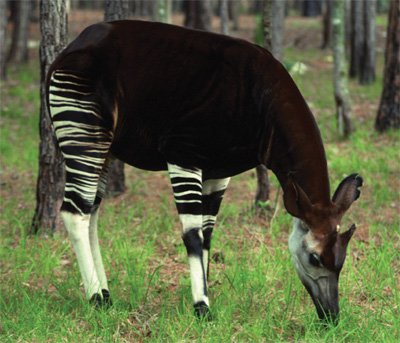The unusual appearance of the okapi provides this animal with excellent camouflage in the forests.
Design

The unusual appearance of the okapi provides this animal with excellent camouflage in the forests when sunlight filters in through the trees. The okapi is part of the giraffe kind; it is not a link between zebras and giraffes, as some scientists claim. If the okapi had a long neck like its relative the giraffe, it would have a difficult time moving through the thick forests.
Features
- The okapi is unusual since its front and hind legs resemble the zebra while other features resemble the giraffe.
- The male okapi has small, hair-covered horns.
Fun Facts
- The okapi’s tongue is long enough to clean out its eyes and ears.
- Its fur is very oily, keeping the animal dry on rainy days.
- The okapi wasn’t known to the scientific world until around 1900, but Pygmies who share their forest home with the okapis have killed and eaten them for centuries.
- The okapi is native just to the Ituri forest of the northeastern part of the Democratic Republic of Congo.
Created Kind Members
Giraffe
CLASS: Mammalia (mammal)
ORDER: Artiodactyla (even-toed hooves)
FAMILY: Giraffidae (giraffe kind)
GENUS/SPECIES: Okapi johnstoni
Size: About 5 ft (1.5 m)
Weight: 440–770 lbs (200–300 kg); Females are larger than the males
Original Diet: Plants
Present Diet: Plants
Habitat: Eastern equatorial rainforest of Africa
Zoo Guide
Make your next visit to the zoo more than just fun—make it factual and fascinating too! You could even start a personal “creation zoo tours” ministry. Featuring more than 100 animals, our long-awaited Zoo Guide includes beautiful pictures and explores the amazing facts and design features that point to our awesome Creator. Excellent gift for any one who loves animals!
Browse Kids Book- © 2024 Answers in Genesis
- Privacy Policy
- Contact
- About

